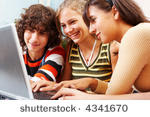1. What is learning to you and why? Link it to the benefits of ICT for students you highlighted earlier in e-Activity 1.
The web definition of learning is as follows
Learning is the process of acquiring knowledge or skill through study, experience or teaching. It is a process that depends on experience and leads to long-term changes in behavior potential. Behavior potential describes the possible behavior of an individual (not actual behavior) in a given situation in order to achieve a goal.
http://www.google.com.pk/search?hl=en&defl=en&q=define:learning&sa=X&oi=glossary_definition&ct=title
One of the most frequently claimed benefits of ICT is that it helps learners to do many “low-order” tasks much more quickly, so that they have time to focus on authentic, higher order, historical thinking. Data handling packages means that pupils do not have to add up tallies, or draw graphs manually: they simply press a button and it is done in an instant. Word processing means that they do not have to laboriously transcribe amended drafts: they can simply cut and paste, ‘drag and drop’ or delete information.
Although ICT does offer these advantages, it does not follow that the time saved is automatically transferred into time spent on more difficult, higher order thinking.
2. Given your view of learning what is teaching to you and why? Link it to the benefits of ICT for your teaching.
In education, teachers are those who teach students or pupils, often a course of study or a practical skill, including learning and thinking skills. There are many different ways to teach and help students learn. This is often referred to as the teacher's pedagogy. When deciding what teaching method to use, a teacher will need to consider students' background knowledge, environment, and their learning goals.
http://www.google.com.pk/search?hl=en&defl=en&q=define:teaching&sa=X&oi=glossary_definition&ct=title
The potential benefits of ICT have not influenced teaching to the extent that might be expected from the influence of ICT in other walks of life. This has highlighted the importance of teachers and others involved in education gaining the knowledge needed to use ICT appropriately so as to exploit the skills which pupils are gaining in ICT for the purpose of learning other subjects.
The role of teacher is changing and the teacher no longer needs to be the main source of knowledge in the classroom. With ICT it is possible for children to learn at different times, in different places, without direct supervision of the expert teacher
3. Given your view of learning and teaching, how would you assess learning?
New forms of student assessment are designed to demonstrate what students are learning and what they can do with their knowledge. Known variously as "alternative" or "more authentic" measures, these assessments require students to "perform" in some way--by writing, demonstrating, explaining, or constructing a project or experiment--so they are also called "performance-based" tests. The idea of such tests is not new. Many classroom teachers routinely evaluate students by asking them to write extended essays or to complete projects, experiments, and portfolios. Here we are using the concept of performance-based assessment used by the Office of Technology Assessment, which defines performance assessment as testing methods that require students to create an answer or product that demonstrates knowledge or skills. Performance assessments may include any of the following categories to items:
Open-ended or constructed response items that ask students to respond in their own words--to "construct" their answers--to questions that may have multiple good answers. Students usually reason out their solutions as part of their answers. Usually students can answer these questions in just a few minutes, and in that way they differ from some of the performance activities described below.
Performance-based items or events: questions, tasks, or activities that require students to perform an action. Although performances can involve demonstrations or presentations, most typically they involve students explaining how they would answer the question or solve a problem by writing a few sentences or paragraphs, drawing and explaining a diagram, or performing an experiment. Such tasks may take from 15 minutes to an hour or more and may involve some work with a group of students who think through the answers and later provide their own individually written answers.
Projects or experiments: extended performance tasks that may take several days or even several weeks to complete. Students generate problems, consider options, propose solutions, and demonstrate their solutions. Students often work in groups, at least for some of the project, to analyze options and to consider ways to present their thinking and conclusions.
Portfolios: collections of student work that show teachers and others who may "score" portfolios the range and quality of student work over a period of time and in various content areas. There are almost as many approaches to compiling and evaluating portfolios as there are proponents of this form of assessment. Portfolios can be used both formally and informally; ideally, portfolios capture the evolution of students' ideas and can be used instructionally and as progress markers for students, teachers, and program evaluators.
http://www.ed.gov/pubs/IASA/newsletters/assess/pt4.html
4. Having explored your views of learning, teaching and assessment, what information will you require planning an ICT integrated lesson / project?
The topic is introduced in an interesting way. It is an opportunity to provide some information but to encourage the students to seek out new information. . It is important not to provide them with everything they need to know, but more the motivation to find out where the student investigates the topic more thoroughly. In these lessons the investigation takes the form of Internet research but it could equally include original research and the use of a variety of problem solving techniques. What is important is that the students are given the opportunity to "free wheel" their way through the materials and not be over directed. We all know however, that they will need some direction and the teacher can circulate, asking important questions, listening to their interactions and ensuring that they remain on task. As teachers, we will all have to resist the urge to be the ones that do the explaining at this point. The student with the opportunity to “explain” or in some way demonstrates their grasp of the concepts after completing their research. The lesson will contain key questions and/or instruction for requiring the student to provide a summary of what they have learned. This can and should, where possible, take the form of class or group discussion as well. The lesson plan the students are expected to work directly on the given assignment. It is their opportunity to demonstrate their application of new information and to present their findings or conclusions to others. It is a good time for submitting materials for evaluation, doing presentations and completing the project or assignment. While it is expected that evaluation will continue throughout the process, this is the section where the teacher evaluates the learning that has occurred. Students normally submit their work or assignments at this point. It is very important at this stage that the students be encouraged to engage in self-evaluation, group evaluation and develop their own tools to do so. The purpose is to examine ways in which they can bring their findings to others or apply their understanding to new and unfamiliar circumstances. Normally, this type of activity will grow out of their excitement for what they have accomplished highly student driven, though teachers may want to gently suggest that the students enter their work in a competition or take their displays to other locations outside of their own school.
Wednesday, July 25, 2007
Subscribe to:
Post Comments (Atom)





































_JPG.jpg)
_JPG.jpg)
_JPG.jpg)
_JPG.jpg)
_JPG.jpg)

No comments:
Post a Comment